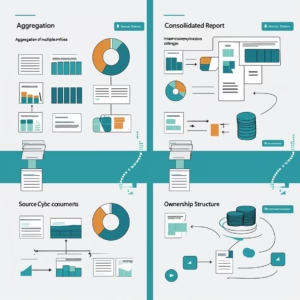Consolidation
-

Mastering Intercompany Dividend Elimination: A Comprehensive Guide for CFOs and Finance Teams
—
Introduction Dividends are among the most common intercompany transactions in group structures. They are also one of the trickiest to manage in consolidation. While dividends represent cash returns to shareholders…
-

A Step-by-Step Guide to Building a Consolidated Cash Flow Statement
—
Introduction Cash is the lifeblood of any business—and for groups with multiple subsidiaries, knowing where cash comes from and where it goes is critical. A consolidated cash flow statement (CFS)…
-

Intercompany Transactions Elimination: Step-by-Step Accounting Process
—
In group accounting, one of the biggest challenges is ensuring that financial statements present an accurate and fair picture of the business as a whole. This means more than simply…
-

The Complete Guide to Intercompany Eliminations in Consolidation
—
When companies grow into multiple entities, transactions between those entities become inevitable. But when it comes time to prepare consolidated financial statements, these intercompany balances can distort the true financial…
-

Consolidation vs Aggregation – What’s the Difference (and Why It Matters)
—
When it comes to financial reporting across multiple companies, the terms “consolidation” and “aggregation” are often used interchangeably—but they are not the same thing. Understanding the difference is essential for…
-

The Role of a Common Chart of Accounts in Group Consolidation
—
When managing a group of companies, especially across different countries or business lines, one of the most critical challenges in financial consolidation is chart of accounts (COA) inconsistency. Each subsidiary…
-

How Do I Run Consolidated Group Financial Statements in MYOB?
—
Introduction: The Challenge of Consolidation for MYOB Users MYOB is a trusted accounting platform for thousands of businesses across Australia and New Zealand. It’s known for its local tax compliance,…
-

How Do I Run Consolidated Group Financial Statements in QuickBooks?
—
Introduction: The QuickBooks Challenge for Multi-Entity Companies QuickBooks is widely used by small to mid-sized businesses for its user-friendliness, affordability, and rich feature set. It helps companies manage bookkeeping, invoicing,…
-

How Do I Run Consolidated Group Financial Statements in Xero?
—
Introduction: Xero and Multi-Entity Reporting Xero is a powerful cloud-based accounting platform used by businesses worldwide. It’s widely appreciated for its simplicity, real-time access, and integrations. However, one common challenge…
